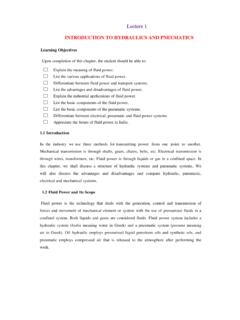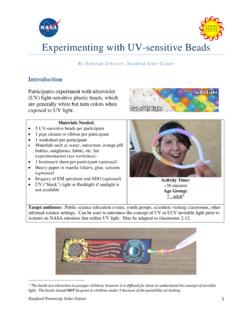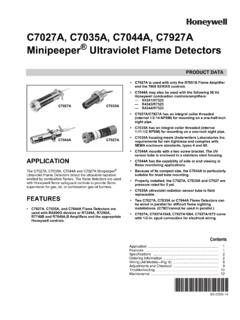Transcription of Module 2 Spectroscopic techniques Lecture 3 Basics of ...
1 NPTEL Biotechnology Bioanalytical techniques and Bioinformatics Module 2 Spectroscopic techniques Lecture 3 Basics of Spectroscopy Spectroscopy deals with the study of interaction of electromagnetic radiation with matter. Electromagnetic radiation is a simple harmonic wave of electric and magnetic fields fluctuating orthogonal to each other (Figure ). Figure : An electromagnetic wave showing orthogonal electric and magnetic components (A); a sine wave (B); and uniform circular motion representation of the sine function (C). A simple harmonic function can be represented by a sine wave (Figure ): = sin ( ). Sine wave is a periodic function and can be described in terms of the circular motion (Figure ). The value of y at any point is simply the projection of vector A on the y-axis, which is nothing but A sin . Equation (1) can therefore be written in terms of angular velocity, . = sin( ) ( ). = sin(2 ) ( ).. = sin(2 ) ( ). where, z = displacement in time t and c is the velocity of the electromagnetic wave If the wave completes cycles/s and the wave is travelling with a velocity c metres/.
2 Sec, then the wavelength of the wave must be metres. 2 . = sin( . ) ( ). Joint initiative of IITs and IISc Funded by MHRD Page 1 of 99. NPTEL Biotechnology Bioanalytical techniques and Bioinformatics Energy of electromagnetic radiation: Energy of an electromagnetic radiation is given by . = = ( ). where h is Planck's constant and has a value of 10-34 m2 kg s-1. Based on the energy, electromagnetic radiation has been divided into different regions. The region of electromagnetic spectrum human beings can see, for example, is called visible region or visible spectrum. The visible region constitutes a very small portion of the electromagnetic spectrum and corresponds to the wavelengths of ~400 780 nm (Figure ). The energy of the visible spectrum therefore ranges from ~ 10-19 to ~5 10-19 Joules. It is not convenient to write such small values of energy; the energies are therefore written in terms of electronvolts (eV). One electronvolt equals 10-19 Joules.
3 Therefore, the energy range of the visible spectrum is ~ eV. Spectroscopists, however, prefer to use wavelength ( ) or frequency ( ) or wavenumber ( ) instead of energy. Figure Electromagnetic spectrum Quantization of energy: As put forward by Max Planck while studying the problem of Blackbody radiation in early 1900s, atoms and molecules can absorb or emit the energy in discrete packets, called quanta (singular: quantum). The quantum for electromagnetic energy is called a photon which has the energy given by equation A molecule can possess energies Joint initiative of IITs and IISc Funded by MHRD Page 2 of 99. NPTEL Biotechnology Bioanalytical techniques and Bioinformatics in different forms such as vibrational energy, rotational energy, electronic energy, etc. Introduction to the structure of an atom in a General Chemistry course mentions about the electrons residing in different orbits/orbitals surrounding the nucleus, typically the first exposure to the discrete electronic energy levels of atoms.
4 In much the same way, rotational and vibrational energy levels of molecules are also discrete. A molecule can jump from one energy level to another by absorbing or emitting a photon of energy that separate the two energy levels (Figure ). Figure Transitions of a molecule between energy levels, E1 and E2 by absorbing/emitting the electromagnetic radiation Electromagnetic spectrum and the atomic/molecular processes: Molecules undergo processes like rotation, vibration, electronic transitions, and nuclear transitions. The energies underlying these processes correspond to different regions in the electromagnetic spectrum (Figure ): i. Radiofrequency waves: Radiofrequency region has very low energies that correspond to the energy differences in the nuclear and electron spin states. These frequencies, therefore, find applications in nuclear magnetic resonance and electron paramagnetic resonance spectroscopy. ii. Microwaves: Microwaves have energies between those of radiofrequency waves and infrared waves and find applications in rotational spectroscopy and electron paramagnetic resonance spectroscopy.
5 Iii. Infrared radiation: The energies associated with molecular vibrations fall in the infrared region of electromagnetic spectrum. Infrared spectroscopy is therefore also known as vibrational spectroscopy and is a very useful technique for functional group identification in organic compounds. Joint initiative of IITs and IISc Funded by MHRD Page 3 of 99. NPTEL Biotechnology Bioanalytical techniques and Bioinformatics iv. UV/Visible region: UV and visible regions are involved in the electronic transitions in the molecules. The Spectroscopic methods using UV or visible light therefore come under Electronic spectroscopy'. v. X-ray radiation: X-rays are high energy electromagnetic radiation and causes transitions in the internal electrons of the molecules. Figure The range of atomic/molecular processes the electromagnetic radiation is involved in. Mechanisms of interaction of electromagnetic radiation with matter: In order to interact with the electromagnetic radiation, the molecules must have some electric or magnetic effect that could be influenced by the electric or magnetic components of the radiation.
6 I. In NMR spectroscopy, for example, the nuclear spins have magnetic dipoles aligned with or against a huge magnetic field. Interaction with radiofreqency of appropriate energy results in the change in these dipoles. ii. Rotations of a molecule having a net electric dipole moment, such as water will cause changes in the directions of the dipole and therefore in the electrical properties (Figure and B). Figure shows the changes in the y- component of the dipole moment due to rotation of water molecule. Joint initiative of IITs and IISc Funded by MHRD Page 4 of 99. NPTEL Biotechnology Bioanalytical techniques and Bioinformatics iii. Vibrations of molecules can result in changes in electric dipoles that could interact with the electrical component of the electromagnetic radiation (Figure ). iv. Electronic transitions take place from one orbital to another. Owing to the differences in the geometry, size, and the spatial organization of the different orbitals, an electronic transition causes change in the dipole moment of the molecule (Figure ).
7 Figure Panel A shows the rotation of a water molecule around its centre of mass (A). The change in the dipole moment as a result of rotation in plotted in panel B. Panel C shows the change in dipole moment of water due to asymmetric stretching vibrations of O H bond. Panel D shows an electronic transition from to * orbital and the geometry of the two orbitals. The above examples suggest that a change in THINK TANK?? either electric or magnetic dipole moment in a molecule is required for the absorption or Will there be a change in the dipole moment if there is emission of the electromagnetic radiation. symmetric stretching of O H. bond in water molecule? Absorption peaks and line widths: Absorption of radiation is the first step in any Spectroscopic experiment. Absorption spectra are routinely recorded for the electronic, rotational, and vibrational spectroscopy. It is therefore important to see how an absorption spectrum looks like. Joint initiative of IITs and IISc Funded by MHRD Page 5 of 99.
8 NPTEL Biotechnology Bioanalytical techniques and Bioinformatics As we have already seen, a transition between states takes place if the energy provided by the electromagnetic radiation equals the energy gap between the two . states = = .. This implies that the molecule precisely absorbs the radiation of wavelength, and ideally a sharp absorption line should appear at this wavelength (Figure ). In practice, however, the absorption lines are not sharp but appear as fairly broad peaks (Figure ) for the following reasons: i. Instrumental factors: The slits that allow the incident light to impinge on the sample and the emerging light to the detector have finite widths. Consider that the transition occurs at wavelength, t. When the wavelength is changed to t +. or t , the finite slit width allows the radiation of wavelength, t to pass through the slits and a finite absorbance is observed at these wavelengths. The absorption peaks are therefore symmetrical to the line at = t.
9 Ii. Sample factors: Molecules in a liquid or gaseous sample are in motion and keep colliding with each other. Collisions influence the vibrational and rotational motions of the molecules thereby causing broadening. Two atoms/molecules coming in close proximity will perturb the electronic energies, at least those of the outermost electrons resulting in broadening of electronic spectra. Motion of molecules undergoing transition also causes shift in absorption frequencies, known as Doppler broadening. iii. Intrinsic broadening: Intrinsic or natural broadening arises from the Heisenberg's uncertainty principle which states that the shorter the lifetime of a state, the more uncertain is its energy. Molecular transitions have finite lifetimes, therefore their energy is not exact. If t is the lifetime of a molecule in an excited state, the uncertainty in the energy of the states is given by: . 4 . ( ).. 2. ( ).. where, = 2 . Two more features worth noticing in the Figure are the fluctuations in the baseline and the baseline itself, which is not horizontal.
10 The small fluctuations in the baseline are referred to as noise. Noise is the manifestation of the random weak Joint initiative of IITs and IISc Funded by MHRD Page 6 of 99. NPTEL Biotechnology Bioanalytical techniques and Bioinformatics signals generated by the instrument electronics. To identify the sample peaks clear of the noise, the intensity of the sample peaks has to be at least 3-4 times higher than the noise. A better signal-to-noise ratio is obtained by recorded more than one spectra and averaging; the noise being random gets cancelled out. Instrumental factors are responsible for the non-horizontal baseline observed in Figure : The light sources used in the instruments emit radiations of different intensities at different wavelengths and usually the detector sensitivity is also wavelength-dependent. A reasonable horizontal baseline for the samples can easily be obtained by subtracting the spectrum obtained from the solvent the sample is dissolved in.

















